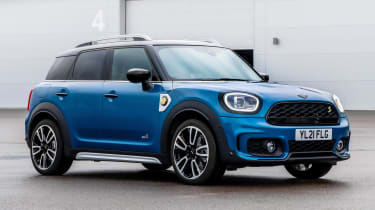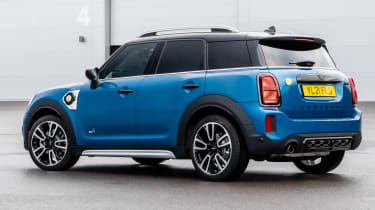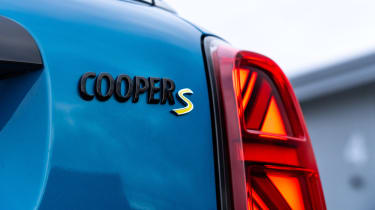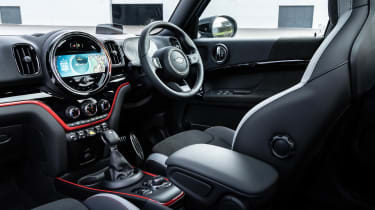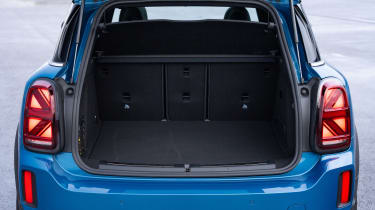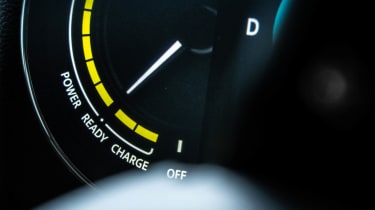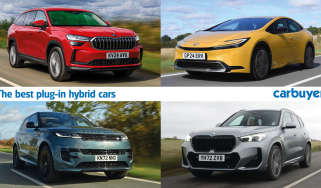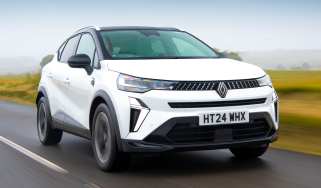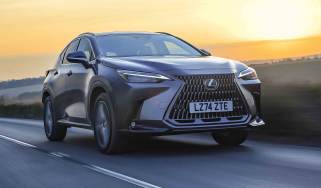MINI Countryman Plug-in Hybrid SUV review
“The MINI Countryman PHEV is cheap to run, fun to drive and quiet in traffic”
Pros
- Low company-car tax
- Suitable for families
- Good to drive
Cons
- Some practicality compromises
- Small petrol fuel tank
- Expensive options
Is the MINI Countryman Plug-in Hybrid a good car?
Aside from the low emissions and everything going on under the metal, the Countryman Plug-in Hybrid is a desirable car. Brisk and just as fun to drive as other models in the range, the Countryman will run rings around most rivals for driver satisfaction, as well as style and badge appeal.
MINI Countryman Plug-in Hybrid range
The MINI Countryman Plug-in Hybrid – previously known as (deep breath) the MINI Countryman PHEV S E ALL4 – is still the only plug-in hybrid model in MINI’s range. If you want to travel anywhere on pure electric power, the best alternative is the smaller MINI Electric.
At its launch, the Countryman PHEV was one of a select few models of its type, but there’s now a range of models petrol-electric plug-in hybrid models to choose from, including the Ford Kuga PHEV, Kia Niro Plug-in Hybrid and Toyota RAV Plug-in Hybrid.
It was updated in 2020 to bring it up to date and still represents an interesting option for company car drivers and those wanting to save money on fuel by plugging in.
The facelift introduced tweaked styling, such as the new Union Jack tail-lights. LED headlights are now standard, while new cars also get a digital instrument cluster first seen in the MINI Electric.
More reviews
Two trim levels are available: Classic and Exclusive. Standard equipment is high, even on the Classic trim, which goes some way to justifying the £38,500 price tag. Highlights include 17-inch alloy wheels, LED headlights, LED rear lights in a Union Jack design, ambient lighting, multi-function steering wheel, 8.8-inch touchscreen with Apple CarPlay, sat-nav and DAB radio, cruise control and automatic headlights.
Exclusive trim adds 18 or 19-inch alloys, leather sports seats, anthracite headlining and Walknappa leather steering wheel. It’s a MINI, so the Countryman PHEV is offered with an array of options and personalisation packs. For £1,800, the Premium Plus pack adds a panoramic sunroof, auto-dimming rear-view mirror, Harman Kardon audio upgrade and everything in the Comfort Plus pack, which includes automatic climate control, heated front seats, a storage compartment pack, front centre armrest, rear-view camera, folding and auto-dimming mirrors and parking assist.
The Untamed special edition, introduced in mid-2022, is also available on the Countryman PHEV. Key features include Momentum Grey exterior paint with Piano Black accents, 18-inch alloys unique to the Untamed trim, black roof rails, Untamed logos on the body and floor mats, leather upholstery in Highland Green and illuminated interior styling upgrades.
The Cooper S badge on the back doesn’t just signify that this is a top-of-the-range model, but that it’s nippy and agile as well: 0-62mph takes just 6.8 seconds because the 1.5-litre petrol engine and the rear-mounted electric motor produce a combined 217bhp. The ALL4 badge shows that it has four-wheel drive as well, so there’s plenty of traction. As with all MINIs, it’s fun to drive.
As part of the 2020 update, the old car’s 7.6kWh battery pack was replaced by a new 9.6kWh battery. It emits just 39g/km of CO2, so the Countryman PHEV is a very cheap car for company car tax – its Benefit-in-Kind (BiK) rating is lower than any other car in the range. It has a range of about 30 miles on electric power alone, which is enough for most commutes. The relatively small battery means recharging doesn’t take very long.
It’s practical for families, too, even if there have been some small sacrifices to get the battery pack to fit. The rear seats are set slightly higher and no longer slide, while the boot shrinks to 405 litres. But the bench splits 40:20:40 and there are chunky roof rails for carrying roof boxes and cycle carriers.
MPG, running costs & CO2
The BMW Group eventually wants to offer every one of its models with the choice of petrol or diesel engines, plug-in hybrid or all-electric propulsion. The Countryman PHEV is a pioneer, checking three of these boxes and becoming the first MINI equipped with the fuel-saving technology. Its battery pack allows an all-electric driving range of up to 30 miles from a full charge – not bad considering 90% of MINI owners drive less than 40 miles a day according to the company’s own research.
In official testing, this helps increase its fuel-economy figure to 156.9mpg. It’s an impressive figure on paper, but real-world results will depend on how far you drive and how often you can top up the batteries. Drive less than 30 miles a day and charge the batteries every night and you’ll hardly use any fuel at all. Head further afield and once the battery charge is depleted, fuel economy will gradually drop to that of a conventional car.
Of great importance is the 41-44g/km CO2 emissions figure, making the Countryman PHEV very attractive to business users thanks to its low Benefit-in-Kind (BiK) company-car tax band. It should mark a big saving over the Cooper petrol, which is the next best Countryman model in the range. Hybrids that you don’t have to plug in, such as some versions of the Kia Niro and the Toyota C-HR, sit in higher tax brackets, where you will pay a higher BiK rate.
After the first year's CO2-based road tax (generally included in the on-the-road price), the MINI Countryman PHEV costs slightly less a year to tax than petrol versions. Ticking a few option boxes can easily cause the price to rise to more than £40,000, at which point you’ll be paying a significantly higher VED (road tax) rate until the car is six years old. You’ll be paying over £500 a year in tax if you breach the £40,000 threshold, negating some of the potential savings in fuel costs compared to a petrol Countryman.
The lithium-ion battery pack has a 9.6kWh capacity and recharging should take less than four hours from a household socket, reducing by an hour and a half if a 3.6kW wallbox is used. The battery comes included in the cost of the car, with no additional leasing required. The battery pack is expected to last the life of the vehicle, but has its own six-year or 60,000-mile warranty for added peace of mind.
Engines, drive & performance
By giving its first plug-in hybrid model a Cooper S badge, MINI is clearly confident it’s no slouch. Getting from 0-62mph in 6.8 seconds vindicates this and makes the Countryman PHEV a much sportier prospect than rivals such as the Mercedes GLA 250 e and Toyota C-HR.
Power comes from a 1.5-litre three-cylinder petrol engine with 134bhp and an electric motor with 87bhp, for a total combined output of 217bhp. Interestingly, MINI has chosen to place the electric motor under the boot floor and send its power directly to the rear wheels, giving the Countryman PHEV its four-wheel drive.
All power from the petrol engine is sent to the front wheels through a six-speed automatic gearbox. Pub trivia fans should note this effectively makes the Countryman PHEV the first rear-wheel-drive MINI when in ‘Max eDrive’ mode, which allows all-electric driving at speeds up to 78mph. Auto eDrive prioritises battery power below 50mph, but acts more like a hybrid, with the petrol engine chiming in for bursts of acceleration. There’s also a setting to favour the petrol engine and save battery power, coming in handy if you plan to visit an urban area later in your trip.
The boost from the electric motor gives the Countryman a surprising turn of speed, especially around town. However, there can be a slight hesitation as you accelerate and the car decides how to proceed, which feels a bit like turbo lag. MINI's engineers have tried to make the plug-in hybrid’s handling similarly agile and precise to the standard model, and the result is one of the most fun PHEVs you can get your hands on.
Interior & comfort
We’ve praised the well-built interior of the standard Countryman and nothing has been sacrificed here, with the same excellent quality and characterful round central infotainment display. Look closely and there are a few reminders of the hybrid technology under the metal, with a bright yellow start/stop toggle switch to press when you want to get going. The instrument gauges had been swapped for a 5.5-inch digital pod perched above the steering column, with a thin bezel and crisp graphics, but current chip shortages mean that most new cars are likely to be fitted with analogue dials.
The Countryman PHEV rides smoothly, something that’s not always guaranteed in a plug-in hybrid. Often, engineers are forced to fit stiffer suspension to deal with the extra weight of the battery pack, but the MINI rides on par with other models in the range. Its upright shape means there’s some wind noise at motorway speeds, but it shouldn’t upset occupants much.
As with the other Countryman models, the PHEV is sold with three basic trim levels. Standard Classic kit includes 17-inch alloy wheels and Piano Black interior trim, along with selectable driving modes and the ability to heat or cool the interior before a journey. Every Countryman also comes with an 8.8-inch infotainment screen, navigation and Apple CarPlay. Sport adds 18-inch wheels and a body styling kit, along with sports seats and a different steering wheel and headlining. Exclusive promotes luxury, adding leather seats, chrome trim and a Satellite Grey headliner.
The Sport trim is temporarily unavailable, with a new Untamed special edition sort of taking its place. It’s a little more expensive than the Exclusive trim it’s based on, but adds striking green upholstery, black exterior trim and unique graphics and wheels.
MINI also includes 4G connectivity as standard on all Countryman models. Dubbed ‘MINI Connected’, the system offers a concierge phone line service, real-time traffic information and improved integration with smartphones, including the ability to send sat-nav information to the car and even operate functions such as the door locks. The Countryman PHEV extends this connectivity to hybrid-specific features, including a charging timer and charging-station search function.
Practicality & boot space
It’s clear the Countryman (which shares its basic underpinnings with the BMW 2 Series Active Tourer plug-in hybrid MPV) was designed with plug-in hybrid technology in mind, because its interior space isn’t too badly affected. The main change is slightly raised rear seats, but the Countryman’s high roofline means there’s still plenty of rear headroom. This change does mean the back seats can no longer slide forwards and back, though.
By positioning the battery pack under the back seats and the electric motor under the luggage compartment, boot space has shrunk by only 45 litres, now measuring 405 litres and still easily beating the Toyota C-HR (377 litres). This is slightly smaller than the Kia Niro (427 litres) and the Mitsubishi Outlander PHEV has a bigger boot still (463 litres), but perhaps not by as much as you might expect given its boxy shape.
The rear seats split and fold in a 40:20:40 configuration, so it’s possible to travel with four adults and place long items like skis or snowboards between your rear passengers. One point to note is that the petrol tank has shrunk from 51 to 36 litres, but MINI claims the extra economy of the Countryman should boost driving range to help make up for it.
Reliability & safety
The MINI Countryman was ranked a disappointing 68th out of 75 in our Driver Power 2023 new car survey, which suggests that reliability might not be a strong point. Having said that, MINI performed well in the brand survey, finishing 15th out of 32 manufacturers. You should also be encouraged by the number of cars that feature several of the Countryman parts, so the electric tech should be dependable.
While it might seem risky to buy MINI’s first foray into plug-in hybrid technology, the brand’s parent BMW has spent huge sums of money on research and development and already implemented the technology in models like the BMW 330e, BMW i3 and BMW 2 Series Active Tourer with great success.
Safety is less of an unknown, thanks to a five-star score for the Countryman in Euro NCAP crash tests. It achieved individual results of 90% for adult occupant protection and 80% for child occupants. Standard safety kit includes autonomous emergency braking and a bonnet that pops up slightly in a pedestrian collision to help cushion the impact.



